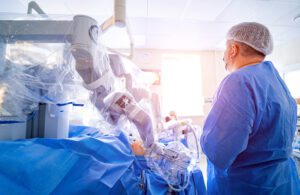
Surgical robotics systems are among the most expensive hospital purchases. [Photo via Adobe Stock]
Medical device manufacturers face volatile equipment orders from hospitals in the next couple of years, with some more exposed to capital budget risk than others.
A new report from Moody’s Investors Service identified eight medtech companies with exposure to changes in hospital capital budgets and examined how well they mitigated that risk with recurring or noncapital sales.
This balance is an important consideration for medtech developers of all sizes as hospitals continue to face staffing and budget challenges with no relief in sight. The report also highlights the importance of innovation in overcoming macroeconomic challenges.
“With a potential recession and inflationary pressures driving up hospitals’ cost of labor, utilities and other expenses, medical device original equipment manufacturers (OEMs) will experience volatile equipment orders from their hospital customers over the next 12-18 months,” the report’s authors warned. “Device OEMs could see reduced order activity as some hospitals pull back on capital spending as liquidity and economic pressures mount.”
They expect some for-profit hospitals to cut capital spending this year, while reporting broad plans across non-for-profit hospitals to increase spending after last year’s cuts.
Major device makers with hospital capital budget risk
The Moody’s analysts behind the report — Michael Weinstein, Ola Hannoun-Costa and TJ Karanian — examined eight large OEMs that report at least 10% of their revenue from capital equipment.
Capital equipment is defined as “long-term physical assets for facility use that are priced at $5,000 or higher,” though the price tag can climb well above that for advanced equipment such as surgical robotics systems, ultrasound machines and positron emission tomography and computed tomography (CT/PET) scanners. MRI imaging and cardiac mapping systems can go for more than $1 million each.
Related: Dr. Fred Moll and Daniel Hawkins discuss the digital OR
All eight companies had high or moderate exposure to capital equipment spending before mitigations. They considered companies with 35% or more of their revenue from capital equipment to be high risk and 10%-35% to be moderate risk. That rated Baxter, GE HealthCare, Medtronic, Royal Philips and Stryker as high risk, and Abbott Laboratories, Becton Dickinson and Boston Scientific as moderate risk.
Of those, Abbott, Becton Dickinson, Boston Scientific, Medtronic and Stryker performed the best at mitigation (more on that below), while Baxter, GE HealthCare and Royal Philips had moderate risk mitigants.
Related: Stryker on steroids: How enabling technology will supercharge surgical robotics
Considering each device maker’s gross exposure and mitigants, the analyst labeled three OEMs as having high overall exposure to hospital capital budgets: Baxter, GE HealthCare and Royal Phillips. They rated Medtronic and Stryker as having moderate overall exposure, and Abbott, Beckton Dickinson and Boston Scientific as having low exposure.
“GE HealthCare and Philips both derive a sizable portion of their revenue from very expensive imaging equipment (e.g. MRIs), which are among the most likely products to face budgetary pressures from hospitals,” the analysts said. “In Baxter’s case, we note that the company’s portfolio will skew further toward capital equipment if and when it completes the announced spinoff of its renal care and acute therapies divisions.”
All eight of the OEMs examined are among the 15th-largest medical device companies in the world, according to Medical Design & Outsourcing‘s 2022 Medtech Big 100 ranking.
Mitigating hospital capital budget risk
Service contracts, consumable products and noncapital devices such as implants can mitigate risk from hospital capital budgets. All eight companies had some product diversification, but the analysts singled some out for special recognition.
At Becton Dickinson, for example, recurring revenue is an estimated 85% of total sales, “driven by hospital products that are not influenced by capital budgets and are considered core operating costs for any healthcare facility from year-to-year.”
Abbott’s diabetes and diagnostics businesses deliver noncapital recurring sales that “help insulate the company from hospital capital budgets.”
Recurring revenue is about 40% of sales at Philips, and while its consumer products offer nonhospital diversification, those products are vulnerable to consumer demand dips in weakening economies.
The power of innovation
Citing Boston Scientific’s cardio product set as an example, the analysts highlighted the power of innovation and product portfolios focused on chronic conditions.
“Innovation continues to have a meaningful impact on forward growth prospects. … Innovation and/or product concentrations that treat certain chronic diseases will continue to drive above-trend organic growth prospects for select competitors over time -— regardless of the macro climate,” the analysts said. “In particular, medical device companies with successful innovation pipelines will continue to see strong demand, driving higher revenue growth.”
The analysts see good prospects for organic growth in medical device sales in the next few years and beyond. With the share of U.S. residents ages 65-plus growing faster than any other age group, they see more and more heart disease, cancer and diabetes patients in the near future.
“With an aging population, instances of chronic disease such as heart disease, cancer and diabetes will continue to grow, which will increase demand for devices that improve clinical outcomes and/or patient mortality rates,” the analysts wrote. “Mission-critical capital equipment. such as imaging or patient monitoring devices, will continue to see healthy organic growth, notwithstanding hospital equipment orders that can be lumpy through the cycle.”
The full report is available for Moody’s Investors Services subscribers.